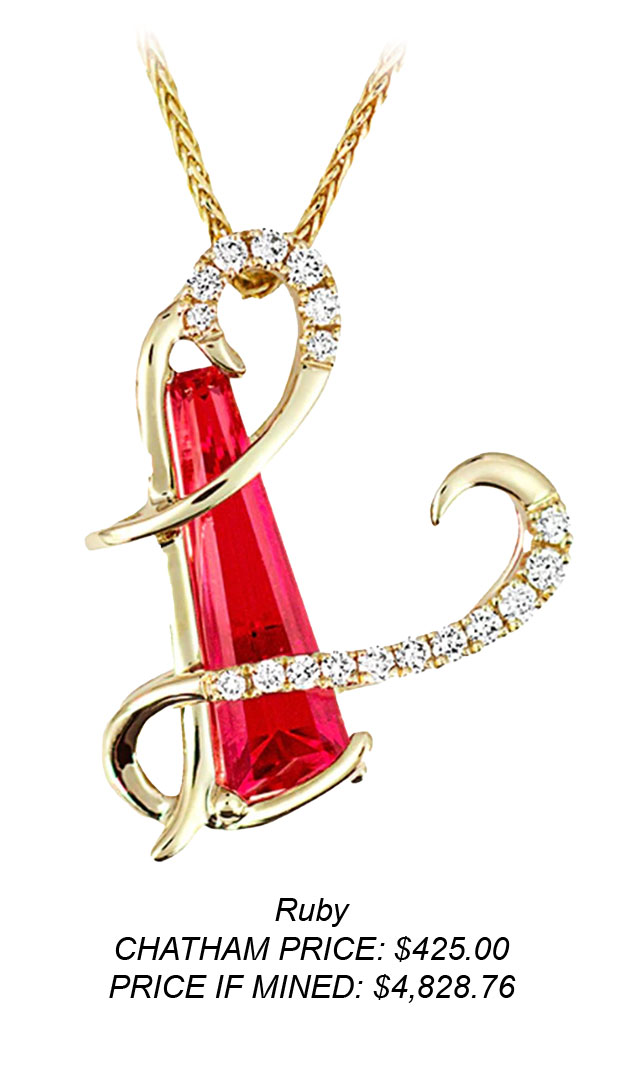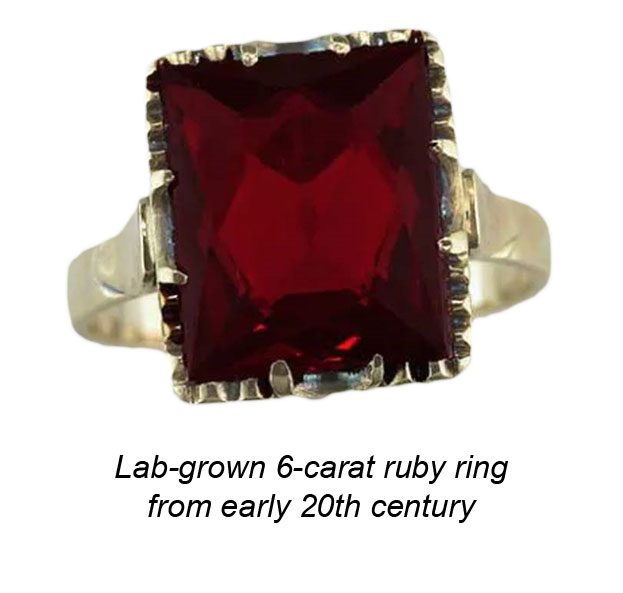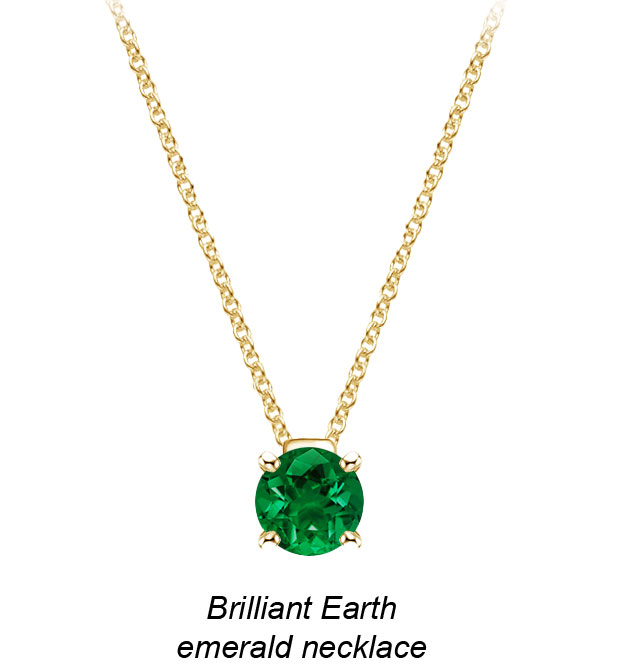Lab-Grown Colored Gems
 Gem-growing is taking off! Labs have been growing colored gems for quite a while, but the increased popularity of grown diamonds, as discussed in previous issues of JII, has given new vitality to colored gems as well.
Gem-growing is taking off! Labs have been growing colored gems for quite a while, but the increased popularity of grown diamonds, as discussed in previous issues of JII, has given new vitality to colored gems as well.
Less expensive
Price is a big customer draw. While colored gems are in general less costly than diamond, the price for fine quality can still be high. Chatham Created Gems, a pioneer in the growing of colored gems, brings that price difference to the fore. With each piece in its Initial Collection, the website shows the price of the jewelry with its Chatham-created gem, followed by the much higher price if the piece had held a mined gem.
Even luxury jewelers known for their mined-gem jewelry have added a line with lab-made gems. Charles and Colvard promotes its new offerings with the phrase Made, not Mined™.
Bigger
For mined material, the size of the deposit of rough limits the size of gem that can be cut from it. As large deposits get depleted, the price of large gems goes up. Labs, on the other hand, have been growing gem material to increasingly larger sizes. Four-carat rubies may soon be commonplace!
 Clearer
Clearer
Clarity treatments like fracture-filling have always been an issue for mined gems, especially emeralds because that gem material is by nature heavily included. Fracture-filling makes the gem look clearer to the unaided eye, but the fracture still exists, leaving the emerald weak and more easily damaged.
An untreated mined emerald of high clarity is extremely rare, so rare that its price can exceed that of diamond. However, lab-made gems, including emerald, have high clarity, making fracture filling unnecessary and making high-clarity gems available for a much lower price.
 More color
More color
Color is the most important feature of a colored gem. Labs have not only produced gems with deep colors and subtle shades. They have added to the chemical mix to produce star sapphires and have created sapphires that mimic the color-changing properties of the rare and valuable alexandrite.
More choice
For some time jewelry websites have had functions that allow a customer to select the gem and the setting. Some retailers now invite the customer to choose the precise color of their gem—for example a sapphire of deep blue, pale blue, purplish blue, etc., and the stone will be created to their specifications.
 Not so new after all
Not so new after all
The increasing profusion of lab-created gems means a big change in the jewelry market, but growing gems is not all that new. Ruby and sapphire were first grown in labs in the late 1800s and by the early 20th century these created gems had found their way into jewelry.
A piece of jewelry set with many small gemstones that need to match in size and appearance might include some lab-made gems along with mined stones.
Grown gems were even used as the main attraction, as in the Art Deco ring pictured here, with its 6-carat lab-made ruby. In fact, today it sometimes happens that prized family jewelry, which an heir assumes to hold valuable gems, turns out to have lab-made gems after all.
Pearls also have a growth history
A pearl begins as an irritant that has worked its way into particular species of oysters, mussels and clams. The mollusk secretes nacre to coat the irritation and, over a long period of time, the result is what we've come to value as a pearl. This pearl-producing phenomenon is quite rare in nature, since only a few mollusk species are involved and the irritant is a matter of chance. In addition, the deep diving needed to retrieve the mollusks is a dangerous effort. Consequently these pearls have been extremely expensive.
 In 1921, after much experimentation by several researchers, "cultured" pearls appeared on the market for the first time. Kokichi Mikimoto had refined a process for seeding mollusks that produced large harvests of pearls far faster than occurred in nature — and eliminated the need for life-threatening diving.
In 1921, after much experimentation by several researchers, "cultured" pearls appeared on the market for the first time. Kokichi Mikimoto had refined a process for seeding mollusks that produced large harvests of pearls far faster than occurred in nature — and eliminated the need for life-threatening diving.
Today cultured pearls are grown on pearl farms in several locations around the world. Far less costly than found pearls, cultured pearls now account for at least 99% of the pearl market.
Is it possible that created diamonds and colored gems will have a similar future?
FOR AGENTS & UNDERWRITERS
Lab-made, man-made, laboratory-grown, created, cultured and synthetic are terms describing real (not imitation) diamonds and other gems made in a lab.
As technology improves and the production of lab-grown gems increases, their price will go down. The situation highlights the importance of keeping valuations up to date.
It's always best to ask for the sales receipt, which will more likely reflect the value of the jewelry. A large discrepancy between purchase price and valuation may indicate a lab-made gem with the valuation of a mined gem.
Be especially cautious with jewelry purchased from auction sites, flea markets, tourist sites and similar questionable sources. There is always a danger of lab-made gems — or even imitation gems !— being passed and priced as their mined counterparts.
All lab-grown gems are not equal. For high-value gems, it's a good idea to have a descriptive report from a reliable grading lab.
These reputable labs offer reports on colored gems that state whether the gem is natural (that is, mined) or synthetic (lab-made). You can use these links to verify reports you receive.
GCAL https://www.gcalusa.com/certificate.html
GIA https://www.gia.edu/report-check-landing
AGL https://www.aglgemlab.com/contact
AGS https://www.americangemsociety.org/agslab/
(AGS is no longer issuing lab reports, but its past reports can be checked using the link above.)
 When insuring colored gem jewelry, it is essential to have an appraisal by a trained gemologist who regularly deals in colored gem jewelry and has the appropriate equipment.
When insuring colored gem jewelry, it is essential to have an appraisal by a trained gemologist who regularly deals in colored gem jewelry and has the appropriate equipment.
The best appraisal includes the JISO 78/79 appraisal form and is written by a qualified gemologist (GG, FGA+, or equivalent), preferably one who has additional insurance appraisal training. One course offering such additional training is the Certified Insurance Appraiser™ (CIA) course of the Jewelry Insurance Appraisal Institute.
FOR ADJUSTERS
With colored gemstones, there is also the possibility of a less expensive gem being passed as a higher-price gem of similar color, such as red garnet being called ruby. Use every means possible to be sure the identification and valuation are accurate — and get that determination in writing.
Take note of brand names on the docs, as some names may indicate producers or retailers of lab-made stones.
Sales receipts and proof-of-payment docs are often helpful in establishing whether a gem is mined or lab-made. Read the fine print!
On a damage claim, ALWAYS have the jewelry examined in a gem lab that has reasonable equipment for the job and is operated by a trained gemologist (GG, FGA+ or equivalent), preferably one who has additional insurance appraisal training, such as a Certified Insurance Appraiser™.
©2000-2025, JCRS Inland Marine Solutions, Inc. All Rights Reserved. www.jcrs.com

